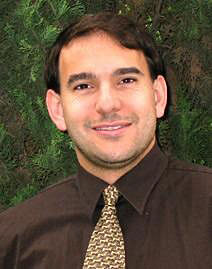It often hides in your basement and is most likely to strike while you’re asleep. This isn’t your ordinary assailant lurking in the dark, however—this is radon: a deadly, odorless, tasteless, colorless gas bred from the decay of radioactive materials. How then do you go about conducting research on such a deadly element? “We worked with the National Institute of Standards and Technology (NIST)—they’d come up with a safe way to produce the gas in the past,” says Ivan Dmochowski, Associate Professor of Chemistry. “They had whole-body scanners, space-agey machines that talk to you and quarantine you if the substance is detected. “
The project, which was first published in the Proceedings of the National Academy of Sciences, was spearheaded by undergraduate first author David Jacobson, whom Dmochowski supervised throughout. The main goal of the experiment was to explore how radon binds to specific molecules—research that in the future might lead to various means of detecting what attracts and deters radon, hopefully making it easier to contain. Jacobson, a student in the Roy and Diana Vagelos Program in the Molecular Life Sciences, came up with the idea after preliminary research on another material, xenon, in which he was using cryptophanes—one-nanometer-diameter organic “cages”—to test binding capabilities.
“We’ve all seen black and white films with their shades of gray—that’s what a regular MRI looks like. Imagine if you could overlay lots of colors that would reveal a higher level of detail.” – Ivan Dmochowski
“I read as much as I could about issues with bonding and ultimately found a method that had been used previously to measure the solubility of radon in various organic solvents,” says Jacobson, a physics and biochemistry major. “With some modification, and after numerous discussions with our NIST collaborators, this yielded the radon binding measurement method.”
The study’s results have wide-ranging implications from a healthcare perspective. Radon is the second leading cause of lung cancer, behind smoking. Because the substance eventually transforms into lead, if it is inhaled long-term, it can become trapped in the lungs in its solidified form and cause severe damage. Jacobson and Dmochowski hope their discoveries regarding radon binding might be able to shed light on a way to reverse engineer an agent that could help rid the body of gaseous radon before it decays into lead in solidified form.
The cryptophane tailoring process that has been a constant throughout the study of both radon and xenon holds additional promises for the healthcare field. Because it has a tendency to fill void spaces, xenon has the ability to act as a sort of molecular probe. In this scenario, researchers would attach molecules targeting cancer-related proteins to a cryptophane and inject it into the patient. Xenon would then be introduced in order to hunt the cryptophane down, filling its empty space and lighting up the area to track potential cancerous cells.
“We’ve all seen black and white films with their shades of gray—that’s what a regular MRI looks like,” says Dmochowski. “Imagine if you could overlay lots of colors that would reveal a higher level of detail, in this case as it relates to certain cancer-associated cells, providing a kind of road map for doctors."
Using xenon as a tracer could potentially allow for less severe intervention. Currently, without complete evidence of a tumor’s potential for metastasis, a physician treating breast cancer might recommend a mastectomy, when in reality the cancer might be treated without such drastic measures.
For Dmochowski, the most rewarding part was seeing the Vagelos program at work. “I think it’s very important for people within the university to recognize the importance of the program, and I think that it’s obvious when you see an undergraduate pulling off this kind of research,” he says. “It is a credit to him, and it is also a credit to the multidisciplinary training that these undergraduates receive.”



